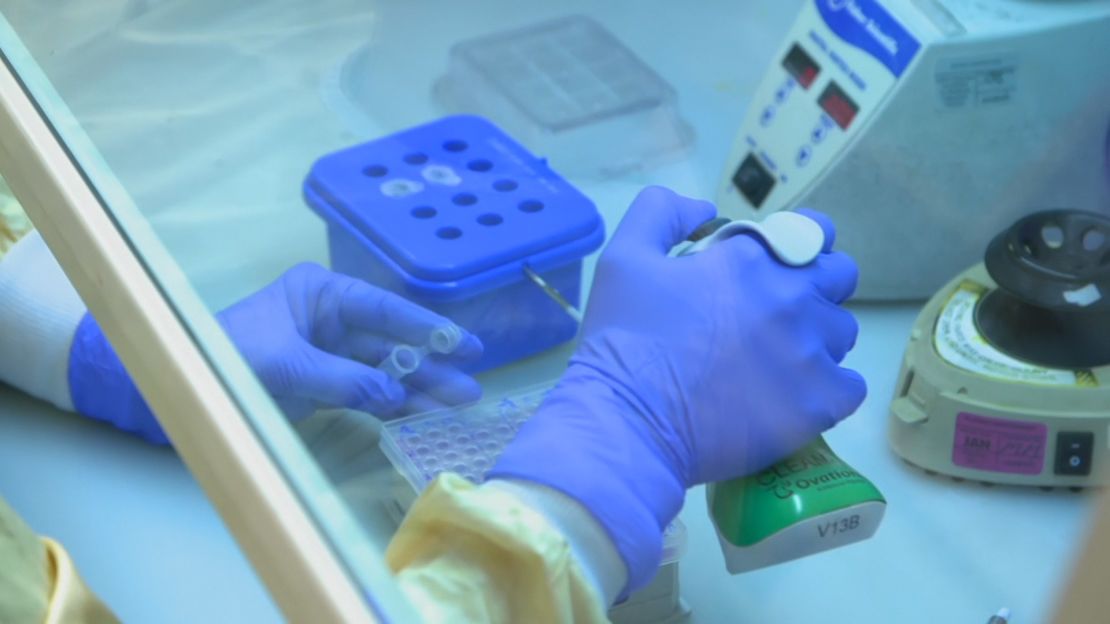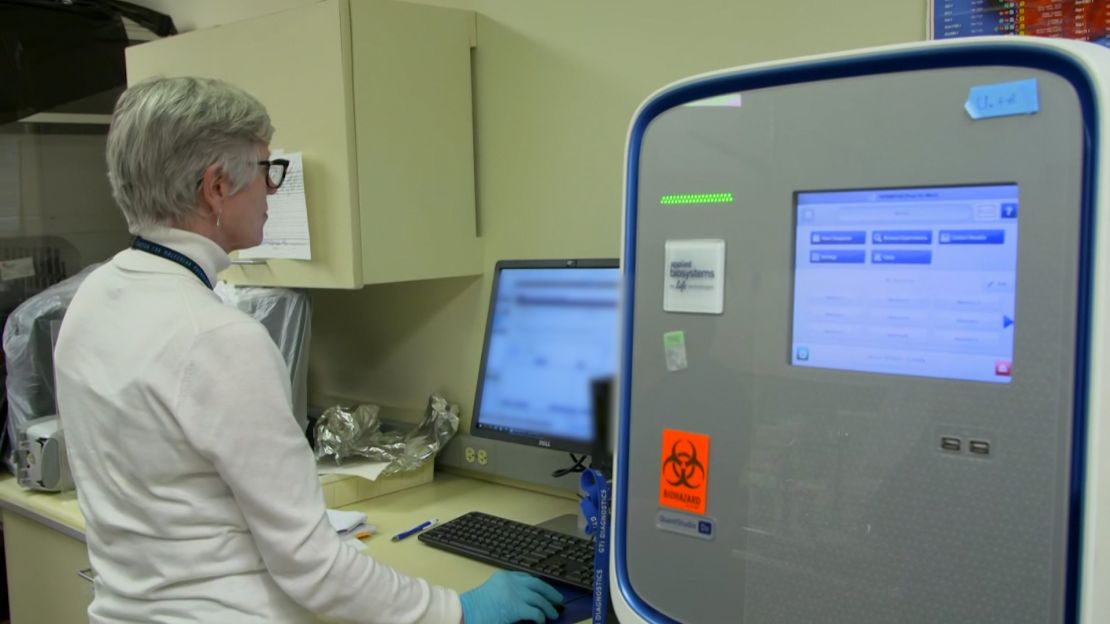CNN Films’ documentary “Unseen Enemy: Pandemic” airs Sunday at 12 am ET.
In ordinary times, the University of Nebraska Medical Center – a sprawling campus situated in the middle of Omaha – is an ordinary hospital.
But these are far from ordinary times. The campus, tucked away in the Great Plains city known for Warren Buffett, Omaha Steaks and corn farms, is teeming with medical experts, working around the clock to combat the coronavirus.
Sleep is in short supply and 20-hour shifts are the norm. These workers, and this center, are on the frontlines of mitigating the unfolding global health disaster.
“This is everything I’ve trained for,” said Dr. Jana Broadhurst, director of the Nebraska Biocontainment Unit Clinical Laboratory, who keeps a cot in her office.
Established in 2005, the biocontainment and quarantine facility was one of only three places equipped to treat some of the 11 patients in the United States stricken with Ebola in 2014.
Now, as the coronavirus crisis has turned into a full-blown pandemic – and with the rapidly expanding number of Americans testing positive for Covid-19, the illness caused by the virus – federal officials are leaning heavily on the facility to help manage the load. It’s where they sent 13 infected passengers aboard the Diamond Princess cruise ship, for instance.
“We are putting out fires around Covid-19 on an hour-by-hour basis,” said Dr. Jeffrey Gold, the chancellor of the University of Nebraska’s Medical Center.
Researchers working on anti-viral drugs for Covid-19
Here, in addition to treating and monitoring coronavirus patients, the facility is a hive of urgent coronavirus research. Clinicians at the Nebraska facility were among the first in the nation to develop their own in-house coronavirus test for people in the Omaha region, who can get results within four to six hours.

Dozens are tested each day for Covid-19 and they’re hoping to ramp daily capacity up to 1,000, said Broadhurst, who spearheaded the development of the test.
Researchers are also working on a NIH-driven study to develop an anti-viral medication that could provide relief. (Think Tamiflu but for coronavirus.)
The difference between the Omaha facility and a regular hospital centers on its ability to minimize the possibility of viral spread from patients stricken with deadly diseases.
Located behind double doors within the larger medical center, the biocontainment wing amounts to a cluster of five sterile hospital rooms where deadly micro-organisms are prevented from circulating through the building by a “negative air pressure” ventilation system.
The quarantine wing houses the less symptomatic patients – so there are fewer visits from staff suited up in protective gear – but all of these rooms, too, are equipped with negative air ventilation.
Putting their day jobs on hold
Perhaps most remarkably, the staff at both the quarantine and biocontainment wings is made up of volunteers – local medical professionals, ranging from nurses to pulmonologists to psychologists to infectious disease experts. This core group of about 70 to 100 specialists snaps to attention when a novel infectious disease threatens to rip through the population, putting their day jobs on hold.

Spurred by the biohazard scares that followed the 9/11 terrorist attacks and the SARS outbreak, the facility opened in 2005 with the 10-bed biocontainment unit – the first in the nation of its size, officials here say. (There are now about 10 such facilities nationwide.)
It sat vacant for nearly a decade before its first real test during the Ebola crisis in 2014, when it was used to treat three Americans – two health care workers and a journalist – who were infected overseas. The Nebraska team was able to save two, but one of the health care workers died.
Some factions of the Omaha community initially found the facility unsettling, said the founder of the biocontainment unit, Dr. Phil Smith, now a retired professor of internal medicine.
“There were a few instances of hate mail going to the chancellor,” he said. “Some letters to the editor: ‘Why are we bringing this dangerous infection into Omaha?’”
But when it became clear after a few weeks that Ebola wasn’t spreading in the city, Smith said he noticed a shift in public opinion.
“It became a source of general interest and pride,” he said.
High stress and mounting pressures are the norm
In the past week, the number of coronavirus patients in the Omaha quarantine and biocontainment units has jumped from 10 to 17.
It began in mid-February, when the facility took in a total of 15 passengers flown in from the Diamond Princess cruise ship docked in Asia. All but two had tested positive. The least symptomatic of them were housed in the center’s quarantine units – which resemble dormitory rooms, complete with TVs and exercise bikes while the most serious cases were admitted to the biocontainment rooms.
About half of that group remains in isolation.
Three of the 17 current coronavirus patients in the Omaha facility are in biocontainment units for the severely afflicted – one is a native of Omaha, a 36-year-old woman who contracted Covid-19 after a trip to the UK.
Health experts often ask coronavirus-infected people with mild or nonexistent Covid-19 symptoms to self-isolate at home. The patients in Omaha are selected to be housed at the facility for two main reasons: their condition is grave enough to warrant treatment in biocontainment, where they are treated and closely monitored by staff members clad in surgical gowns, plastic gloves and a face shield. Or their home situation is such that self-isolating is dangerous – perhaps they live with an elderly person with underlying health conditions, for instance.
Given the dangerous, high-pressure nature of the work, the medical staff finds itself grappling with issues of high stress and, on occasion, subtle social ostracism.
One was disinvited from a birthday party. Another – a swing dance hobbyist – has been turned away by prospective dance partners when they learn of her line of work.
“More than one member of our team have spouses whose employers have asked them to work remotely rather than reporting to work,” said David Cates, a psychologist who treats staff and patients at the National Quarantine Unit, and who in his regular job functions as the director of behavioral health at Nebraska Medicine. “And this despite the fact that there is no reason to believe the health care workers themselves have the disease.”
‘The Hot Zone’ triggered her passion for research
But these occasional social pitfalls do not outweigh the rewards.
Dr. Angela Hewlett, the medical director of the biocontainment unit in her volunteer role – and a clinical infectious disease specialist in her regular job – relocated from Texas to work at the Omaha facility. Her passion for the field was triggered by a book, “The Hot Zone.” She read the nonfiction thriller about Ebola as a college student in the 1990s.
“To see a patient who’s incredibly sick with an illness like Ebola or like the coronavirus get better is exceptionally rewarding,” Hewlett said.
It’s looking like one of those recovered patients will be Carl Goldman, who has been in isolation in Omaha for 28 days.
As panic spreads, he is calling for people to stay calm.
“Stress is the worst thing for your immune system,” he said, speaking to CNN via Skype from his room.
Goldman, 67, was on the Diamond Princess when he tested positive for the coronavirus.
Goldman learned through testing that he’d been infected for four days before showing any symptoms. They kicked in with a fever that reached 103 degrees and ended with a lingering dry cough that finally subsided a couple of days ago, he said.
Although Goldman is still testing positive – he will be able to leave after testing negative on three consecutive days – he said the symptoms are gone.
“The (vast majority of) people who are getting it are getting it with mild, mild symptoms, similar to us,” he said, referring to a friend on the cruise who also came down with the virus. “So, you don’t need to be afraid.”
But as the number of cases surges, it’s clear that even the medical experts at the Omaha facility are worried for their families.
Shelly Schwedhelm, executive director of emergency management and biopreparedness at UNMC’s sister campus, Nebraska Medicine, said her son works at the hospital as a nurse, and his wife is pregnant.
Schwedhelm, who lives on a farm, said her daughter-in-law will soon move there by herself, and Schwedhelm will move into town with her son for a time.
“That’s what we’ll do when things really ramp up and he and I are in the throes of caring for people on the front line,” she said. “We just choose to not risk being around a pregnant wife.”
This story has been updated to clarify that individuals who have tested positive for Covid-19 are asked to isolate or are in isolation, not quarantine.






